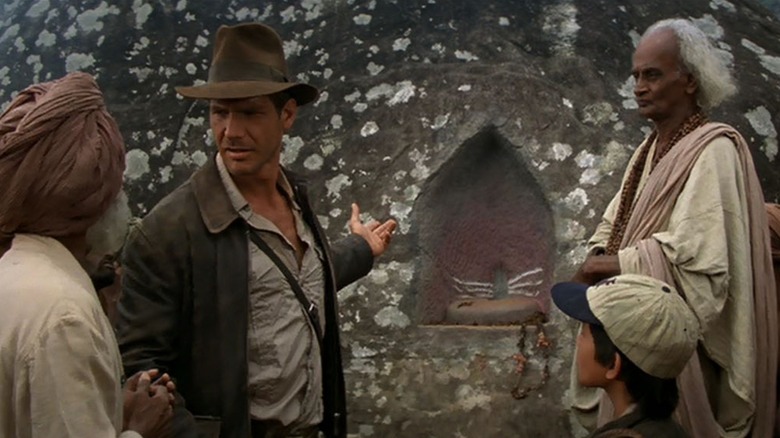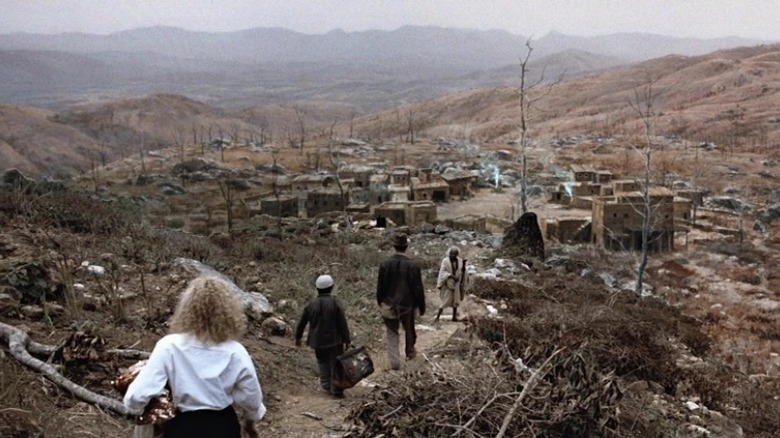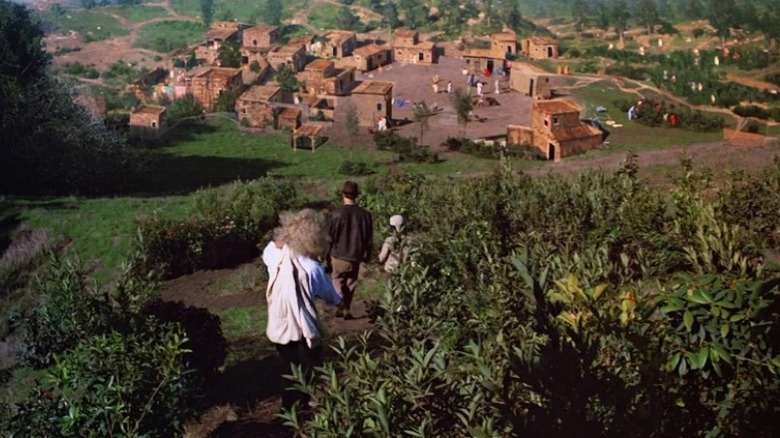One Indiana Jones And The Temple Of Doom Location Posed A Chronological Challenge
Steven Spielberg's 1984 film "Indiana Jones and the Temple of Doom" moves at a breakneck pace, seeing its title character (Harrison Ford) survive a black market artifact deal, the death of an old friend, a poisoning, a shootout in a night club, a plane crash, a sled ride down a snowy mountain, and a dangerous river rafting excursion before the plot even begins in earnest. It's not until Indy exits that raft and steps ashore in a small village in India that his quest becomes clear.
The village of Mayapore, Indy finds, has fallen into starvation and destitution due to an ill-defined parasitic influence coming from a local palace. It seems that evil members of a cult, operating out of said palace, have come to Mayapore, kidnapped all the children, and stolen their sacred Sankara stone, a magical artifact that seemingly kept the village verdant and well-fed. The cult of Thuggee has been forcing the Mayapore children to work in their mines beneath Pankot Palace, digging for additional stones, which they intend to use in demonic rites. Indy must go to Pankot, solve several mysteries, and rescue the village.
At the start of "Temple of Doom," Mayapore is brown and dying, resting miserably among muddy hills. When Indy returns triumphant at the end of the film, Sanakara stone in hand and children in tow, Mayapore has instantly become green and lovely once again. See the pictures below for a comparison.
It seems to shoot the village, the filmmakers had to shoot the verdant scenes first. This process was detailed in "Indiana Jones and the Temple of Doom: Official Collector's Edition," a making-of book published in 1984, and currently readable through the Internet Archive.
Shooting in reverse
Production designer Elliot Scott noted that the Sri Lankan location where "Temple of Doom" was shot looked perfect. The village was built out as a set, using local clay sources as building materials. He explained:
"We chose a post way up in the mountains, near Kandy. Working from models and drawings I had done in England after our reconnaissance trip, a Sri Lankan Art Director used local labor to construct the village set. We had chosen a site in an old tea plantation on very hilly terrain and they did a first class job constructing this village, which consisted of about 20 clay houses including a great water wheel. Clay cracks wonderfully when it dries and the effect was excellent."
Kandy is a historically significant city, as it was the capital of Sri Lanka during its era of ancient kings. It's still the capital of the island's central province.
The establishing shot establishes the destitution of the village well. The problem arose when he had to transform the village into something green by the end of the film. By a lucky stroke of timing, the mountain tea plants were in full bloom when the crew arrived, and were about to start dying out for the season shortly thereafter. It was just a matter, then, of getting the bushes on film while they still had leaves, and then waiting until they turned brown for the remaining scenes.
Green tea
Scott said plainly:
"Our problem was that in the movie, Indiana Jones arrives at the village when it is desolate and by returning the magic stone transforms it back to health at the end of the story. We solved this by shooting events chronologically backwards. So we filmed the scenes at the end first, when all the tea bushes were green and fresh, and then grubbed out the bushes to create a dead area later."
It's a simple solution, but one that does require some thought and innovation. From the look of it, Spielberg and Scott also employed some matte paintings for the sequence of greenery.
Weirdly, most fans of "Indiana Jones and the Temple of Doom" will likely point out that the main plot of the film is a little oblique. Indiana Jones is indeed on a quest to find a Sanakara stone and rescue children, but Mayapore arrives so late in the film's proceedings, and Indy spends so little time there, that one has to actively and regularly remind themselves what Indiana Jones is doing at Pankot. The set pieces in "Temple of Doom" are slick, gross, and memorable, but the actual story isn't terribly well-written.
Scott did an exemplary job of designing Mayapore, but Steven Spielberg might have done a better job of looking around the village more and showing how destitute it truly was, allowing the audience — and Indy — to develop a connection to it. For the most part, Indy's adventures are only abstractly heroic. We can rest easy, though, that Mayapore is saved and the children are safe.


